Birds of Southern Africa
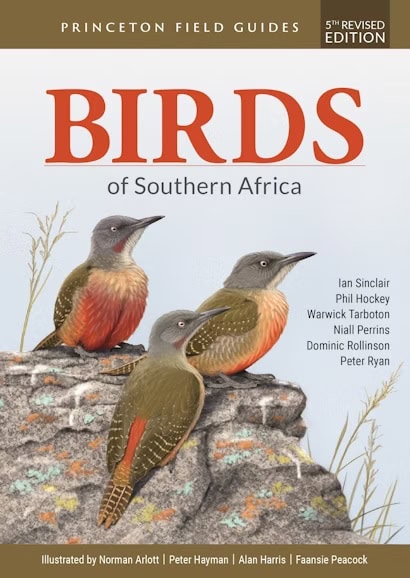
Princeton Birds of Southern Africa Fifth Editon 2023
This is an excellent book if you go to any of the countries listed in the chart below. It is a bit heavy for a field guide with 488 pages, but displaying more than 800 species from many countries makes it necessary.
Layout
The book uses the typical layout with birds on the right and maps and text on the left.
Quality of Images
Four artists have created excellent drawings. Each species has two or more images. Most images are a good size, not tiny, as in some books.
Maps
The maps are small, but that is necessary as they cover most of southern Africa. They show the locations of resident species, summer visitors, and winter visitors. Northern residents must remember that summer and winter are reversed in the Southern Hemisphere.
An extra feature is that each colour has two shades, with the darker version showing where the birds are common and the lighter colours showing where they are less common. Nice. Usually, these are combined, showing only the total distribution.
Test and Taxonomic Order
The text for each species is necessarily brief but sufficient to describe the bird and the status of scarcity, common or rare. It also describes the habitat where the species are found.
No specific taxonomic order is followed; however, the species are listed mostly in the order that birders are familiar with. This means penguins are in the front of the book, and small passerines such as finches, blackbirds, and sparrows are toward the back.
Information about similar species to the one you have in mind is not included. This is common, and most guidebooks do not include this information.
The Index
The index is sometimes a weak spot in an otherwise excellent guidebook. However, that is not the case with this book. In fact, it has several indexes as follows:
- Inside the front cover is an index featuring images organized by family, without text. This is a really good, handy feature. Most birders can identify the family of their bird, if not the species name. One needs only to scan the two-page chart for an image of a bird in the same family as the one you are researching and then turn to that page number.
- The following page has a list of family names and page numbers.
- Pages 14 and 15 show a list of endemic species. Few guidebooks have this information in one place. If you see a bird on this list and want more information, return to the family index for the page number. The fact that a species is endemic is also included with the species text as in other guidebooks.
- At the back of the book are several more indexes. The first one is for scientific names. We prefer to see the scientific names listed separately. Mixing them alphabetically with the English names makes using the index tedious.
- Next, there is an index in Afrikaans. It is good to have an index in the local language. This enables you to get help from people who do not speak English. If you are looking for a particular species, you may have to ask for the bird’s name, as the locals call it. Not very many guidebooks have this feature.
- Finally, there is an English index. The species names are indented under the family names, and only the family names are in alphabetical order. We have not seen this type of index before, but we really like it. It is very easy to find the family you want and all the species in that family instead of scattered throughout the index in alphabetical order.
We wish all guidebooks were as easy to use as this one.
Print Quality
The print quality of this book is excellent, as is typical for Princeton publications.
Extra Features
In the segment for Albatrosses, there is a two-page section showing drawings of ten species of Albaratros heads, with examples of adult and juvenile for each species. This is in addition to the regular drawings, maps and text for Albatrosses. This is a good feature as many of them are alike.
Another bonus of this book is that each description has a bar code that allows you to listen to the birds’ calls after downloading an app. Although the book is a bit heavy, it would be worth having in the field with you for this great feature.
Above the text for each species is a small bar that shows which months the bird is present. It shows months in dark green for breeding season, light green for non-breeding, and white if the bird is not present for that month. This is a nice feature, as it is no use searching for a bird that is not present when you are there.
Conclusion
Birdtripper highly recommends this book. It is one of the best guidebooks we have seen. The extra features mentioned above include the dark and light map shades to indicate if the species is common or scarce, as well as the bar codes for the bird calls.
For Birdtripper Members only
Click the Members page to join.
Birdtripper members get 30% off Princeton books. Click members to register.
(M) Write a review
You must be logged in to submit a review. Go to Members page to Log-in or Register
Birds of Greater Southern Africa
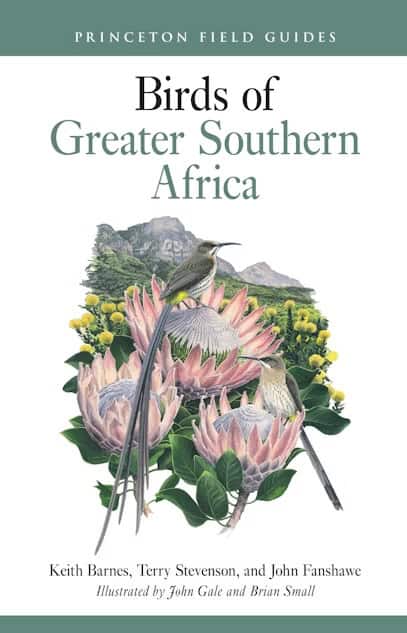
Princeton Birds of Greater Southern Africa 2024
Similar to the book above with the addition of more countries. See the chart below for comparison.
This is a heavy book with 640 pages. It covers 1,198 species
Layout
The book follows the standard layout with images on the right and maps and text on the left.
Quality of Images
The drawings are very good, with at least two of each species.
Maps
The maps are small, but that is necessary as they cover all of southern Africa. They show the locations of resident species, summer visitors, and winter visitors.
Text and Taxonomic Order
The text for each species gives a good description, status, and habitat. Information about similar species to the one you have in mind is not included. This is common, and most guidebooks do not include this information.
The Taxonomic Order follows the Birdlife International checklist.
Index
This book lacks the index using pictures that is inside the front cover of the book described above. Near the front is a list of family names with page numbers.
At the back of the book are several indexes as follows:
- First, there is a 19-page section on vagrants and birds of the Southern Ocean Islands that is not covered in the main part of the book.
- Next is a six-page list of endemic birds of the countries covered in the book.
- Next is a five-page list of endangered species, showing their conservation status and the country where they can be found.
- Next is an appendix showing the Birding Hotspots on a map for each country covered in the book. This is a great feature we have not seen in any other book.
- Finally, there is a standard index similar to the one in the book above, with the family names in bold and the species names indented under their respective families. This makes it much easier to find the species you are looking for instead of everything in alphabetical order. All the birds of a family are together, although some names are very different and are typically scattered throughout the index in alphabetical order. We really like this type of index and have seen it only in Princeton books. The scientific names are also listed but not in a separate index.
Additional Features
Although it lacks some of the features of the book above, it has some different ones.
It has a 14-page section on habitat. There are two maps, one showing habitat areas and the other showing elevation. There is a segment for each type of habitat. For example, savanna, forest, desert, grasslands, and several others. It does not mention birds in this section, but the text for each species tells you the habitat where that bird can be found, and you can match up the text, habitat description and habitat map to find likely places to see the species you are seeking. Also, the plants’ height is compared to an average human’s height with a drawing for each vegetation type. This information and the hotspot maps mentioned above can help you locate desired species.
At the top of each text page, there is a coloured bar with the family name. If you are familiar with the taxonomic order and know approximately where in the book to find the family you want, you can skim through a section of the book, reading the headings instead of using the index.
Conclusion
This is a good book, but unless you are going to some of the countries not mentioned in the previous book, we suggest going with the first option. This book is much thicker and heavier as it covers more countries.
Each of these books has some great features that are not found in the other, such as the hotspot map in the second book and the many different indexes and bird calls in the first book.
(M) Write a review
You must be logged in to submit a review. Go to Members page to Log-in or Register
Comparison
Birds of Southern Africa
- Namibia
- Botswana
- Zimbabwe
- Southern Mozambique
- South Africa
- Lesotho
- Eswathi
- Light & dark shades on maps for common & uncommon areas
- Monthly presence bar
- Bird calls
- Afrikaans language index
- Family picture index
Birds of Greater Southern Africa
- includes all of the countries covered in the Southern Africa book, as well as:
- Zambia
- Malawi
- Northern Mozambique
- hotspot maps
Birds of Botswana
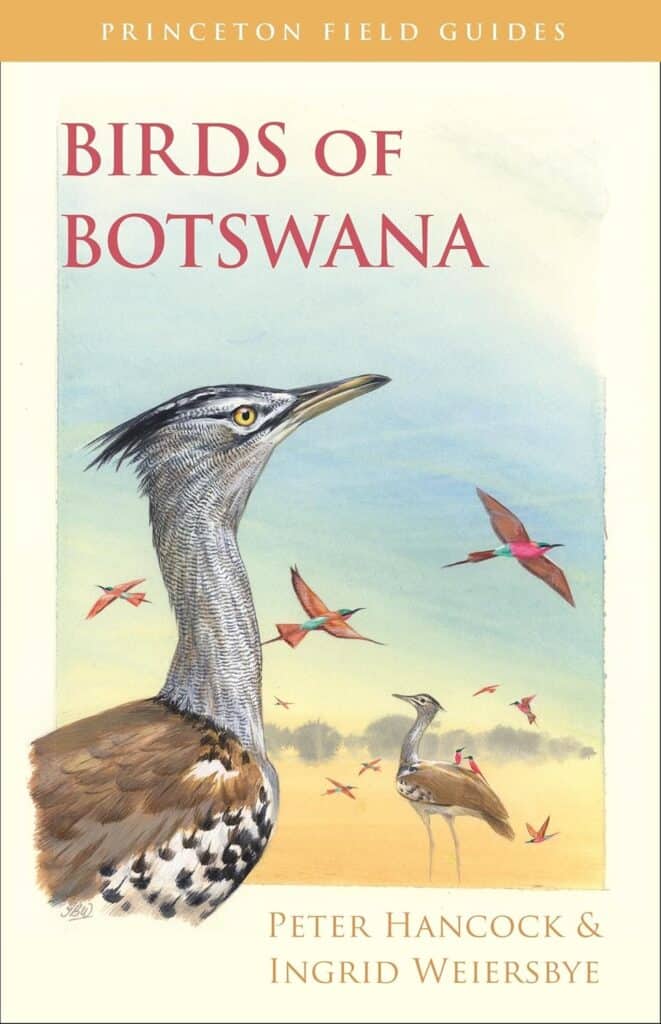
Princeton Birds of Botswana 2016 by Peter Hancock
This book is for you if you are going only to Botswana and no other countries in Southern Africa.
Layout
The book follows the standard layout with images on the right and maps and text on the left.
Quality of Images
Excellent large drawings with only three or four per page by Ingrid Weiersbye.
Maps
The maps show the distribution area for both resident and migrant birds.
Like the Southern Africa book described above, this book’s maps have two shades, with the darker colours showing where the birds are common and the lighter colours showing where they are less common. This is a really nice feature to help you locate the species you are seeking instead of the standard maps that show the total area in one shade.
Text and Taxonomic Order
The text for each species is more extensive than most guidebooks, as there are a maximum of four species per page. So, there is a lot of space for information about each species, including call, resident status, abundance, habitat, conservation status, and identification data.
In addition, there is a paragraph at the beginning of each family describing its characteristics. However, family breaks do not always occur at the top of a new page.
The taxonomic order is unknown, but the species names align with the International Ornithological Congress World Bird List 4.3.
Information about similar species to the one you have in mind is not included. This is common, and most guidebooks do not include this information.
The Index
Inside the front cover is an alphabetical index of family names, which is quite handy if you know the family name but not the species name you seek.
A few pages in, there is a list of scientific names with page numbers under “Contents.” The list is in order of appearance in the book, not alphabetical order.
The index at the back has English and scientific names in alphabetical order with species names indented. There is no bolding and no break between letters of the alphabet. I always correct this deficiency by printing a large letter at the start of each new letter of the alphabet.
Additional Features
Like the Southern Africa book, each species has a bar showing the months the bird is present. The bar is grey for the month that the species is present and white when not present. Instead of a letter “B” to indicate the breeding season, the bar has a black dot. A large dot means this is a peak egg-laying month. A small dot indicates less egg-laying, and no dot means the bird is present but not nesting.
Near the front of the book is a map showing vegetation types, which helps to find species by habitat. Next are five pages describing the various habitats in Botswana, with a picture of each landscape.
Following the habitat section is a two-page list called “Where to see birds in Botswana.” There are no maps, but each hotspot is described, along with the species found in its area.
Print Quality
Like all Princeton books, the print quality is excellent, and the glossy pages should withstand plenty of use in the field.
Conclusion
This is an excellent field guide, and we highly recommend it. If you are also visiting other countries, we still recommend taking this bird for the Botswana portions of your trip in addition to one of the South Africa books described above. Individual species are easier to find in this book than searching through a thick book covering several countries. Also, the large, excellent drawings with a maximum of four per page make identification much easier.
Birdtripper members get 30% off Princeton books. Click members to register.
(M) Write a review
You must be logged in to submit a review. Go to Members page to Log-in or Register
Birds and other Wildlife
Even hard-core birders will want to see other wildlife on a trip to Africa. We will not write reviews for these books but list them for your convenience and offer a few comments. It might be necessary to ID snakes if you get bit by one.
Birdtripper members can write a review if they have these books.
Wildlife of Southern Africa
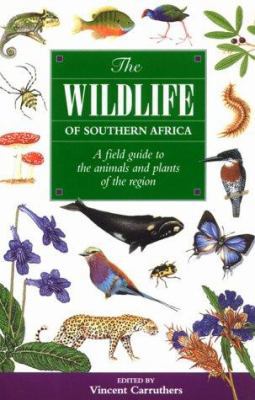
Struik pulblicatn by Vincent Carruthers 2008
This is a nice book. However, it contains an extensive section on plants, which may not interest everyone. There is only a small amount of text for each species and no species maps. The drawings are small but of good quality. They should be good enough to ID most wildlife. There are a few general maps showing habitat and topography. There are separate indexes for Arachnids, Insects, Fish, Frogs, Reptiles, Birds, Mammals, and Plants. It’s a good book, but the bird section is not good enough for serious birders. You would still need one of the bird Field Guides described above. Make sure you get the 2008 revised edition and not an older one.
Similar species to the one you are investigating are suggested. This is a really good feature.
You must be logged in to submit a review. Go to Members page to Log-in or Register
Southern Africa
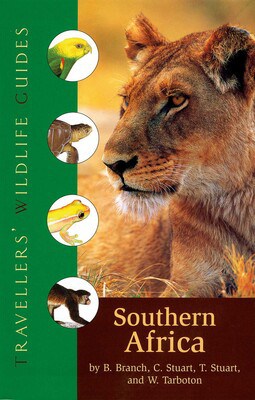
Interlink Books publication by Branch, Stuart, Stuart and Tarboton. 2007
The drawings in this book are bigger and better than in the previous book. There is little text information and no species maps, but it does state the habitat and general region where the species are found. It doesn’t include plants or insects. There is a good map showing all the national parks and game reserves, with a text description of each park and the species you might find in each.
The drawback is that it is a thick, heavy book, and half is devoted to general text about the species. This is good if you want in-depth data on wildlife; otherwise, it is too heavy for a field guide. We think the previous book is better unless you want a lot of background data on the species.
You must be logged in to submit a review. Go to Members page to Log-in or Register
Mammals of Southern Africa
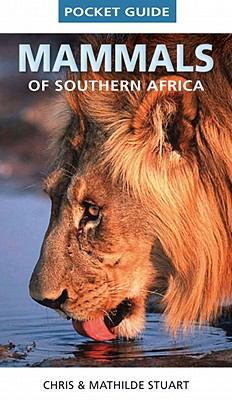
Struik publications by Stuart and Stuart 2011
This book is about mammals only, but it is a very good book similar to the bird field guides. It has photos on the right and text and maps on the left. There are mostly one or two species per page, with more than one large photo of each, plenty of description text, and a destruction map.
An index of animal tracks is at the back.
There are several editions of this book. Make sure you get the newest one (2011).
If you are interested in birds and mammals but not insects, reptiles, or other forms of wildlife, get this book and a bird guide.
You must be logged in to submit a review. Go to Members page to Log-in or Register
Mammals of Namibia
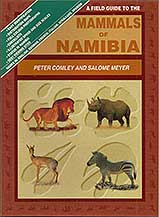
An Africa Window publication by Comley and Meyer 1997
Get this book if you are only travelling in Namibia. It is a thin, lightweight book that will not burden you with much weight. The book is old, but the wildlife has not changed except perhaps for their population and range.
It is packed with information, with one species per page. There are range maps, tracks, and even a comparison in size to a human. It describes habitat, best viewing locations, status, and other information. The only drawback to this book is the very small photos.
You must be logged in to submit a review. Go to Members page to Log-in or Register
.